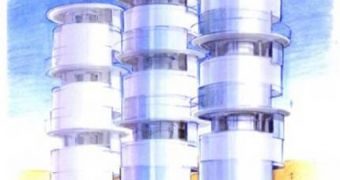Deserts such as Sahara, Atacama, or Gobi, are so dry, that water cannot be found for hundreds of miles. The ground is cracked over miles and miles, and little to no vegetation endures. Cacti are almost the sole forms of life, together with snakes and other creatures adapted to the demands of living without water. However, humans cannot survive in those conditions, at times not even when they carry the appropriate equipment. Now, researchers are proposing the creation of a new class of structures that would directly synthesize water from the humidity of the air.
For example, in the Negev desert of Israel, experts estimate that the humidity in the atmosphere is at about 64 percent around the year, which means that each cubic meter of air stores about 11.5 milliliters of water. Tapping into this resource could at least bring more water to the people from the air, if not help create irrigation systems.
A plant designed to absorb this kind of moisture would not have such a large output, but it would certainly make a difference. Researchers at the Fraunhofer Institute for Interfacial Engineering and Biotechnology IGB, in Stuttgart, Germany, working with colleagues from the Logos Innovationen company, have managed to develop a way of drawing water from air humidity.
The new design does so autonomously and in a decentralized manner, as in without needing too much oversight, or an operation center. “The process we have developed is based exclusively on renewable energy sources such as thermal solar collectors and photovoltaic cells, which makes this method completely energy-autonomous. It will therefore function in regions where there is no electrical infrastructure,” the IGB department head, Siegfried Egner, says.
The basic operating principle of the new tower-shaped structures is very simple. Briny solutions (with large concentrations of salt), run through pipes on the tall towers, and attract water vapors onto them. When they reach the bottom of the towers, the solution enters a reservoir, which is constantly under vacuum. Because of the lower pressure, the boiling point of the solution is reduced below 100 degrees Celsius.
Heat coming from solar panels is concentrated on the briny substance, which is now diluted by the accumulated water. Because of the heat, pure, non-saline water is collected through a series of filled tubes, in which it flows in a controlled fashion. Thus, a constant vacuum is kept in the chamber above, and no vacuum pump is needed. The briny solution, again without water, rises to the top of the tower, and begins its descent once again. The process is cyclical, and only requires sunlight to operate.

 14 DAY TRIAL //
14 DAY TRIAL //